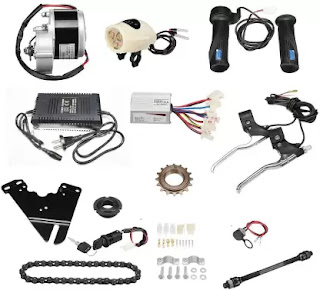Converting a normal bicycle into an electric bicycle, also known as an e-bike
1. Select an E-Bike Conversion Kit: There are various e-bike conversion kits available in the market. Choose a kit that suits your needs, preferences, and budget. These kits typically include a motor, controller, battery, throttle, and other necessary components.
2. Gather Tools and Equipment: To complete the conversion, you'll need some basic tools such as wrenches, screwdrivers, pliers, and wire cutters. Additionally, you may need a torque wrench, spoke wrench, and possibly a bike repair stand for convenience.
3. Remove Rear Wheel: Start by removing the rear wheel of your bicycle. This will allow you to install the e-bike conversion kit properly. Follow the instructions provided with your kit or consult the manufacturer's guidelines for specific details.
4. Install the E-Bike Conversion Kit: Mount the motor to the frame or rear wheel hub as per the manufacturer's instructions. Attach the controller, throttle, and other components according to the provided guidelines. Connect the wiring harnesses securely and route them along the frame to avoid interference or damage.
5. Mount the Battery: Determine the ideal location for the battery based on its size, weight, and balance. Common options include mounting it on a rear rack, inside a frame bag, or on the downtube using specialized brackets. Ensure the battery is securely attached to the frame to prevent vibrations or movement.
6. Connect and Test Components: Connect the motor, controller, throttle, and battery according to the wiring diagram provided by the conversion kit manufacturer. Double-check all connections to ensure they are properly secured. Test the system by turning on the battery and checking if the motor responds to throttle input.
7. Fine-Tune the System: Adjust the settings on the controller, if applicable, to match your preferences and riding style. Some kits may offer options such as pedal assist levels, speed limits, or regenerative braking. Refer to the manufacturer's instructions for specific details on adjusting these settings.
8. Reinstall Rear Wheel and Adjust Brakes: Put the rear wheel back in place and make sure it is securely attached. Check the brake alignment and adjust the brake pads if necessary. Ensure that the brakes function properly and are capable of stopping the bike effectively.
9. Safety Check: Before taking your newly converted e-bike for a ride, perform a thorough safety check. Verify that all components are securely fastened, wires are properly routed and protected, and that the brakes, lights (if included), and other essential functions are working correctly.
Please note that the conversion process may vary depending on the specific e-bike conversion kit you choose. Always refer to the manufacturer's instructions and guidelines for the most accurate and up-to-date information. Additionally, if you're not confident in performing the conversion yourself, it's advisable to seek assistance from a professional bike mechanic or an e-bike specialist.







Post a Comment